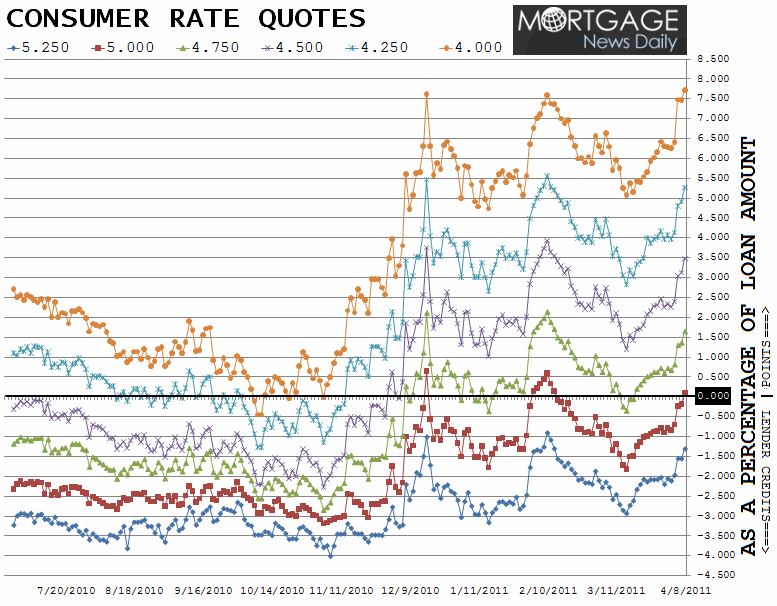Mortgage rates moved higher this week following a RELEASE OF STORED ENERGY.
The chart below graphs the average origination closing costs tied to specific note rates (as quoted by the five major mortgage lenders). Our most updated chart does a great job illustrating the recent spike in home loan borrowing costs. Stored energy was released in an unfriendly direction!
If the note rate line is moving up, the closing costs associated with that note rate are rising.

Each line represents a different 30 year fixed mortgage note rate. The numbers on the right vertical axis are the origination closing costs, as a percentage of your loan amount, that a borrower would be required to pay in order to close on that note rate. If the note rate graph line is below the 0.00% marker, the consumer may potentially receive closing cost help from their lender in the form of a lender credits. If the note rate line is above the 0.00% marker, the consumer should expect to pay additional points at the closing table to cover permanent buydown costs and origination fees. PLEASE SEE OUR MORTGAGE RATE DISCLAIMER BELOW
CURRENT MARKET: The "Best Execution" conventional 30-year fixed mortgage rate has risen to 5.125% after spending an extended period stuck at 4.875%. For those looking to permanently buy down their rate to 5.00%, this quote carries higher closing costs but the upfront fee to permanently buy down your rate to 5.00% is worth it to applicants who plan to keep their new mortgage outstanding for longer than the next 5 years. Ask your loan officer to run a breakeven analysis on any origination points they might require to cover permanent float down fees. On FHA/VA 30 year fixed "Best Execution" is STILL 4.75%. 15 year fixed conventional loans are now best priced at 4.25%. Five year ARMS are stratified and there is more variation in what will be "Best-Execution" depending on your scenario. We recommend break-even-analysis for several potential rates.
VERY IMPORTANT CAVEAT: Mortgage rates are being quoted in a wider range right now due to recent regulatory changes in Loan Officer Compensation policies. Because of this, the Best-Execution mortgage rate can vary greatly from lender-to-lender. The quotes we have listed above are on the more aggressive side of the primary mortgage market.
PREVIOUS GUIDANCE: The move higher in Best-Execution mortgage rates could be a brief foray into unpleasant territory or merely the beginning of a new trend of higher rates. Though there's no way to know for sure if economic data or news headlines will show up any time soon to ease the pain, the possibility that they WON'T is enough for us to suggest the following: Until further notice, your decision to lock or float should assume that rates will get worse before they get better, if they get better. Believe it or not, we are STILL able to conceive of a rates rally if the underlying bond markets are able to hold their ground at some important nearby levels. We'll let you know if they do and point you in the direction of more detailed analysis if you want it, but for now, it's fair to say the lock bias has ticked up a notch in intensity.
CURRENT GUIDANCE: Today is simple and the current guidance will be simple until current trends change. Plain and simple: after being stuck in the same spot for several weeks, mortgage rates have finally made a directional move. Unfortunately that direction wasn't consumer friendly. We'd be in lock mode until rates aren't rising any more, or at least until rates so some motivation to stop rising. We'll let you know when we feel it's safe to confirm that, but until then, take the lock bias we've been favoring for the past month and double its intensity.
What MUST be considered BEFORE one thinks about capitalizing on a rates
recovery?
1. WHAT DO YOU NEED? Rates might not recover as much as you
want/need.
2. WHEN DO YOU NEED IT BY? Rates might not recover as fast as you
want/need.
3. HOW DO YOU HANDLE STRESS? Are you ready for MORE VOLATILITY in
the bond market.
---------------------
"Best Execution" is the most efficient combination of note
rate offered and points paid at closing. This note rate is determined based on
the time it takes to recover the points you paid at closing (discount) vs. the
monthly savings of permanently buying down your mortgage rate by 0.125%.
When deciding on whether or not to pay points, the borrower must have an idea
of how long they intend to keep their mortgage. For more info, ask you
originator to explain the findings of their "breakeven analysis" on
your permanent rate buydown costs.
Important Mortgage Rate Disclaimer: The "Best Execution" loan
pricing quotes shared above are generally seen as the more aggressive side of
the primary mortgage market. Loan originators will only be able to offer these
rates on conforming loan amounts to very well-qualified borrowers who have a
middle FICO score over 740 and enough equity in their home to qualify for a
refinance or a large enough savings to cover their down payment and closing
costs. If the terms of your loan trigger any risk-based loan level pricing
adjustments (LLPAs), your rate quote will be higher. If you do not fall into
the "perfect borrower" category, make sure you ask your loan
originator for an explanation of the characteristics that make your loan more
expensive. "No point" loan doesn't mean "no cost" loan. The
best 30 year fixed conventional/FHA/VA mortgage rates still include closing
costs such as: third party fees + title charges + transfer and recording. Don't
forget the intense fiscal frisking that comes along with the underwriting
process.
---------------------




